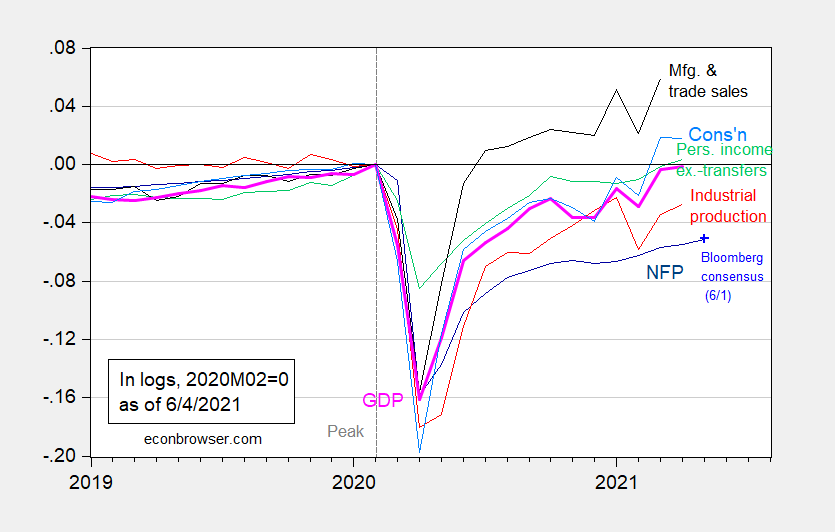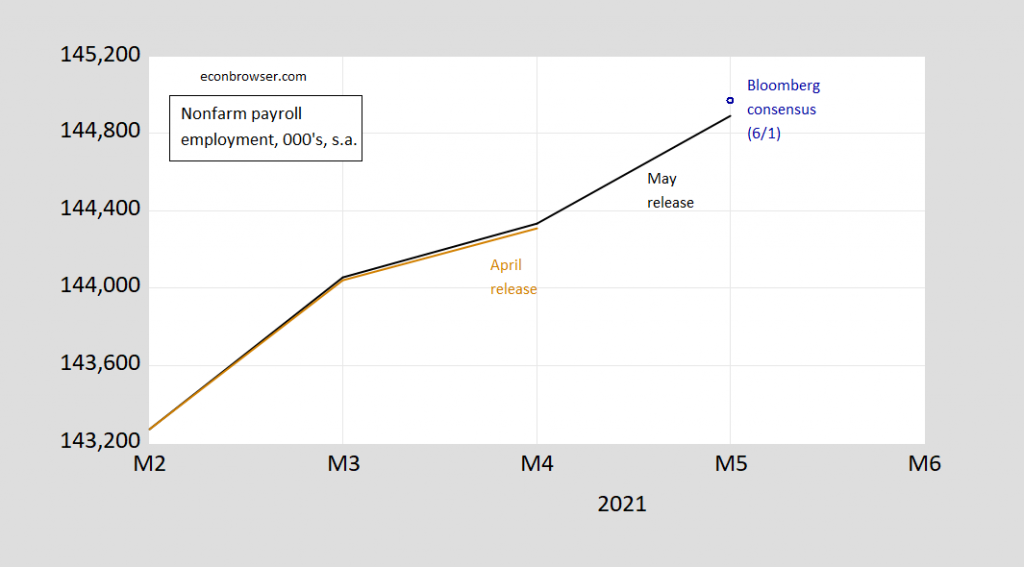Employment figures were released today, showing continued growth. In the context of key macro indicators followed by the NBER Business Cycle Dating Committee:
Figure 1: Nonfarm payroll employment from May release (dark blue), Bloomberg consensus as of 6/1 for May nonfarm payroll employment (light blue +), industrial production (red), personal income excluding transfers in Ch.2012$ (green), manufacturing and trade sales in Ch.2012$ (black), consumption in Ch.2012$ (light blue), and monthly GDP in Ch.2012$ (pink), all log normalized to 2020M02=0. Source: BLS, Federal Reserve, BEA, via FRED, IHS Markit (nee Macroeconomic Advisers) (6/1/2021 release), NBER, and author’s calculations.
Here’s a close-up of employment.
Figure 2: Nonfarm payroll employment, May release (black), April release (brown), Bloomberg consensus for May (blue square), calculated by adding predicted May change to April preliminary. Source: BLS, Bloomberg, and author’s calculations.


“Figure 2: Nonfarm payroll employment, May release (black), April release (brown), Bloomberg consensus for May (blue square)”
So employment growth was decent but a bit below forecast. As Tony Kornheiser would say “we’ll try to do better next time”.
The first law of forecasting: forecasts are always correct; actual results are usually wrong.
D.Trump forecasts: if Biden wins, the stock market will crash, you’ll have a depression like you’ve never seen before, your 401K will go to hell…..
Some true believers went for those forecasts hook, line, and sinker. Not you, right?
Bruce Hall told Ford a year ago that 2021 sales would suck. It seems they stopped buying semiconductor chips based on that dumb forecast and his even dumber advocacy of Just in Time inventory management. But when Ford faced the inevitable chip shortage – Bruce is running all over the place blaming everyone but himself. Yes – he is that damn stupid!
pglly, you seem to need to make up nonsense in order to amuse yourself… since it amuses no one else.
You also like to mischaracterize my comments. For example, your statement that I advocate JIT when, in fact, I pointed out the strategic frailty of JIT in a long-distance supply chain. You should read more carefully before you insert foot in mouth.
The first law of reading a Bruce “no relationship to Robert” Hall – get ready for side aches from laughing too hard at his latest stupidity. I would ask could you say something more stupid but then it is guaranteed you will.
The first law of piggly wiggly is that making up nonsense is better than dealing in facts. Too bad piggly wiggly doesn’t have anything of value to offer.
Now now, Bruce. Piggly Wiggly is a small chain of pretty decent grocery stores in parts of the Midwest. They certainly do have things of value to offer. Tsk tsk.
I was always more of a Fareway guy myself. But then I always liked Younkers better than Macy’s, so what the hell do I know??
https://cepr.net/jobs-2021-06/
June 4, 2021
Economy Adds 559,000 Jobs in May; Unemployment Drops to 5.8 Percent
By DEAN BAKER
Black teen unemployment hit a record low of 12.1 percent in May.
The May employment report was somewhat weaker than had generally been expected, with the economy adding 559,000 jobs. On the household side, the unemployment rate fell by 0.3 percentage points to 5.8 percent. While this is still high by any reasonable measure, it is worth noting that the unemployment rate did not get this low following the Great Recession until October of 2014.
[Graph]
The employment-to-population ratio (EPOP) edged up to 58.0 percent, which is 3.1 percentage points below the pre-pandemic level. By this measure, the gender differences in the hit from the pandemic have largely disappeared, the women’s EPOP for May was 53.1 percent, down 2.3 percentage points from its average in 2019. For men the May EPOP was 63.4 percent, down 3.2 percentage points from its year-round average of 66.6 percent in 2019. However, in payroll employment, women’s share was 49.8 percent in May, compared with 50.0 percent before the pandemic.
(It is important to note that states that ended unemployment insurance supplements would not likely affect the May data. The termination did not take effect until June, the reference point for the survey is May 12th.)
Private Sector Performance Was Strong, as Governments Lag in Rehiring Workers
The private sector accounted for 492,000 of the May job growth, as state and local governments added back just 78,000 workers in the month (the federal government lost 11,000 jobs). State and local employment is still 1,191,000 below its pre-pandemic level, with the vast majority of this gap in education. With the end of the regular school year this month, pandemic closings will be less of an issue in June, but presumably all schools will be open again for in-class instruction in the fall.
The private sector is down 6,462,000 jobs since February 2020. At the May rate of job growth, it will take just over 13 months to make up the gap.
Restaurants Biggest Source of Job Gap
In absolute numbers, restaurants make up the largest chunk of this shortfall, with employment still down 1,480,000 from the pre-pandemic level, after adding 186,000 jobs in May. While many employers claim that they aren’t hiring because they can’t find workers, it’s not clear how much impact this shortage is having. Wages have been rising rapidly for nonsupervisory workers in the industry, a 22.2 percent annual rate comparing the average of the last three months (March, April, and May) with the prior three months (December, January, and February), but the average workweek actually fell slightly in May, from 25.3 hours to 25.1 hours.
On the plus side, the index of aggregate hours in the industry is still 12.4 percent below its pre-recession level. With restaurant sales likely passing their pre-pandemic level in May, this implies a huge gain in productivity. This is true more generally, as the overall index of aggregate hours for May stood 3.6 percent below the February level, even as output is virtually certain to pass pre-pandemic levels in the quarter.
Big Job Gains in Most Troubled Sectors
The health care sector, which is down 508,000 jobs from before the pandemic, added 22,500 jobs in May. Nursing care facilities, which are down 202,000 jobs, added back just 1,000 jobs in May, after losing 17,700 in April. This is a sector where low and poor working conditions may make it difficult to attract workers.
Hotels, which are down 526,000 jobs, added 34,600 jobs in May. The other services category, which includes sectors such as hair salons and dry cleaners and is down 353,000 jobs, added 10,000 jobs in May. The retail sector, which is down 411,000 jobs, actually lost 5,800 jobs in May. This is another sector where it seems there have been strong productivity gains. The motion picture sector, which is among the worst hit in percentage terms, down 157,000 jobs or 35.6 percent, added 13,900 jobs in May.
Construction and Manufacturing Coping with Shortages
Construction lost 20,000 jobs in May after losing 5,000 in April. This is likely due to temporary shortages of building material, most importantly lumber. Manufacturing added 23,000 jobs, reversing most of the job loss in April, as it seems auto manufacturers are finding ways to deal with the semiconductor shortage.
Recovery Continues to Benefit More Educated Workers
The unemployment rate for college grads fell 0.3 percentage points to 3.2 percent in May. It is down 0.8 percentage points from the start of the year. By contrast, the unemployment rate for high school grads dropped just 0.1 percentage points to 6.8 percent. It has fallen 0.3 percentage points since January.
Black Teen Unemployment Hits a Record Low
The unemployment rate for Black teens fell to 12.1 percent in May, by far the lowest level on record. These data are highly erratic, so we may see a big jump in future months, but it does seem to indicate they are doing relatively well in the current labor market.
The overall Black and Hispanic unemployment both dropped 0.6 percentage points in May, to 9.1 percent and 7.3 percent, respectively. The unemployment rate for Asian Americans is still somewhat higher than for whites, 5.5 percent compared to 5.1 percent for whites. It was slightly lower pre-recession….
https://fred.stlouisfed.org/graph/?g=rbas
January 4, 2018
Average Hourly Earnings of All Private Workers, 2017-2021
(Percent change)
https://fred.stlouisfed.org/graph/?g=EvBa
January 4, 2018
Average Hourly Earnings of All Employees in Education and Health Services, 2017-2021
(Percent change)
https://fred.stlouisfed.org/graph/?g=EvBd
https://fred.stlouisfed.org/graph/?g=EvBg
January 4, 2018
Average Hourly Earnings of All Employees in Manufacturing, 2017-2021
(Percent change)
January 4, 2018
Average Hourly Earnings of All Employees in Construction, 2017-2021
(Percent change)
Why the 2018 links? Those hardly seem relevant.
My apologies if my memory is failing me, but I think our good friend baffling predicted this. [ loud and respectful applause directed at Mr. baffling’s perceptive abilities from the golf gallery ]
https://www.huffpost.com/entry/trump-communications-platform-blog-fails_n_60b7923ae4b00a70313af97c
Certainly quite baffling how he was able to do it, :-).
Here is the exact comment. I wanted to make sure Baffling got his just due. Some will say that it was easy to call. But I thought it was pretty insightful in the immediacy of the moment since the orange creature’s blog just got started. It’s one of those things after the time goes by you think “Of course!!! Why didn’t I see it?!?!?!”, But for it to hit baffling’s vision in that moment, I thought was a shining moment for Mr. Baffling:
https://econbrowser.com/archives/2021/05/distributional-data-from-the-national-income-and-product-accounts#comment-252632
BTW, this says something positive for “off topic” comments. There have been a few gems on this blog, and I think Menzie allowing a little room on the margins for that freedom in comments (and Menzie has been exceedingly tolerant) benefits the blog. Who else was saying trump’s blog would fail at that time?? I wager not too many, and the few who were, mostly partisans. Baffling stated it in a very neutral way based on a pragmatic view of trump’s past behavior.
Moses,
Well, I was just wisecracking while accepting about baffling calling it, not questioning that he did.
But now that you have provided the link, it is less obvious to me that baffling really did call it. He seems to have predicted that the blog would get massively hacked and that this would be what would bring the blog down, whereas in fact it looks like Trump got disgusted because his viewership was so low and falling and he could not stand getting ridiculed over this.
In any case, I am glad to see his blog fail, and let us give baffling some credit for saying it would fail, even if it appears he did not get precisely what would bring it down right.